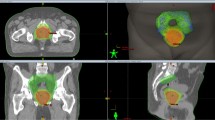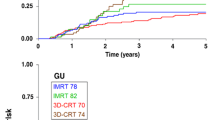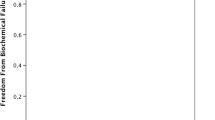Abstract
Purpose:
To evaluate toxicity after dose-escalated radiotherapy for prostate cancer using intensity-modulated treatment planning (IMRT) and image-guided treatment (IGRT) delivery.
Patients and Methods:
100 patients were treated with simultaneous integrated boost (SIB) IMRT for prostate cancer: doses of 76.23 Gy and 60 Gy in 33 fractions were prescribed to the prostate and the seminal vesicles, respectively, for intermediate- and high-risk patients (n = 74). The total dose was 73.91 Gy in 32 fractions for low-risk patients and after transurethral resection of the prostate (n = 26). The pelvic lymphatics were treated with 46 Gy in 25 fractions in patients with high risk of lymph node metastases using an SIB to the prostate (n = 25). IGRT was practiced with cone-beam computed tomography. Acute and late gastrointestinal (GI) and genitourinary (GU) toxicity was evaluated prospectively (CTCAE v3.0).
Results:
Treatment was completed as planned by all patients. Acute GI and GU toxicity grade ≥ 2 was observed in 12% and 42% of the patients, respectively, with 4% suffering from GU toxicity grade 3. 6 weeks after treatment, the incidence of acute toxicity grade ≥ 2 had decreased to 12%. With a median follow-up of 26 months, late GI and GU toxicity grade ≥ 2 was seen in 1.5% and 7.7% of the patients at 24 months. Four patients developed late toxicity grade 3 (GI n = 1; GU n = 3). Presence of acute GI and GU toxicity was significantly associated with late GI (p = 0.0007) and GU toxicity (p = 0.006).
Conclusion:
High-dose radiotherapy for prostate cancer using IMRT and IGRT resulted in low rates of acute toxicity and preliminary results of late toxicity are promising.
Zusammenfassung
Ziel:
Erfassung der Toxizität nach intensitätsmodulierter (IMRT), bildgeführter Strahlentherapie (IGRT) des Prostatakarzinoms.
Patienten und Methodik:
100 Patienten wurden wegen eines Prostatakarzinoms mittels IMRT und simultanen integrierten Boosts (SIB) primar bestrahlt: Gesamtdosen von 76,23 Gy bzw. 60 Gy in 33 Fraktionen wurden im Boostzielvolumen und in den Samenblasen geplant, falls ein hohes oder intermediares Risikoprofil vorlag (n = 74). Bei niedrigem Risiko und Zustand nach transurethraler Prostataresektion wurde eine Gesamtdosis von 73,91 Gy in 32 Fraktionen angewendet (n = 26). Das pelvine Lymphabflussgebiet wurde bei hohem Risiko eines Lymphknotenbefalls mit 46 Gy in 25 Fraktionen behandelt (n = 25), ebenfalls mit einem SIB auf die Prostata. IGRT wurde mittels Cone-Beam-Computertomographie praktiziert. Die akute und chronische gastrointestinale (GI) und urogenitale (GU) Toxizitat wurde prospektiv nach CTCAE v3.0 erfasst.
Ergebnisse:
Die Behandlung wurde bei allen Patienten planmäßig beendet. Akute GI- und GU-Toxizitat ≥ Grad 2 wurde bei 12% bzw. 42% der Patienten beobachtet; 4% entwickelten eine GU-Toxizitat Grad 3. 6 Wochen nach Therapie war die Inzidenz einer Toxizität ≥ Grad 2 auf 12% zurückgegangen. Nach einer medianen Nachbeobachtungszeit von 26 Monaten wurde eine 2-Jahres-GI-bzw. -GU-Toxizitat ≥ Grad 2 bei 1,5% bzw. 7,7% der Patienten beobachtet. Vier Patienten entwickelten eine Spätnebenwirkung Grad 3 (GI n = 1; GU n = 3). Das Vorhandensein von akuter GI- und GU-Toxizität war mit einer signifikant höheren Inzidenz an späten GI- (p = 0,0007) und GU-Nebenwirkungen (p = 0,006) assoziiert.
Schlussfolgerung:
Radiotherapie mit hohen Bestrahlungsdosen resultierte in geringer Akuttoxizitat bei Anwendung von IMRT und IGRT; vorläufige Daten zur chronischen Toxizität sind vielversprechend.
Similar content being viewed by others
References
Al-Mamgani A, Heemsbergen WD, Peeters ST, et al. Role of intensity-modulated radiotherapy in reducing toxicity in dose escalation for localized prostate cancer. Int J Radiat Oncol Biol Phys 2009;73:685–91
Al-Mamgani A, van Putten WL, Heemsbergen WD, et al. Update of Dutch multicenter dose-escalation trial of radiotherapy for localized prostate cancer. Int J Radiat Oncol Biol Phys 2008;72:980–8
Arcangeli G, Saracino B, Gomellini S, et al. A prospective phase III randomized trial of hypofractionation versus conventional fractionation in patients with high-risk prostate cancer. Int J Radiat Oncol Biol Phys:2010; 78:11–8
Arcangeli S, Saracino B, Petrongari MG, et al. Analysis of toxicity in patients with high risk prostate cancer treated with intensity-modulated pelvic radiation therapy and simultaneous integrated dose escalation to prostate area. Radiother Oncol 2007;84:148–55
Bayley A, Rosewall T, Craig T, et al. Clinical application of high-dose, image- guided intensity-modulated radiotherapy in high-risk prostate cancer. Int J Radiat Oncol Biol Phys 2010;77:477–83
Bohrer M, Schroder P, Welzel G, et al. Reduced rectal toxicity with ultrasound- based image guided radiotherapy using BAT (B-mode acquisition and targeting system) for prostate cancer. Strahlenther Onkol 2008;184:674–8
Bolla M, de Reijke TM, Van Tienhoven G, et al. Duration of androgen suppression in the treatment of prostate cancer. N Engl J Med 2009;360:2516–27
Bos LJ, van der Geer J, van Herk M, et al. The sensitivity of dose distributions for organ motion and set-up uncertainties in prostate IMRT. Radiother Oncol 2005;76:18–26
Brenner DJ. Fractionation and late rectal toxicity. Int J Radiat Oncol Biol Phys 2004;60:1013–5
Chung HT, Xia P, Chan LW, et al. Does image-guided radiotherapy improve toxicity profile in whole pelvic-treated high-risk prostate cancer? Comparison between IG-IMRT and IMRT. Int J Radiat Oncol Biol Phys 2009; 73:53–60
D’Amico AV, Chen MH, Renshaw AA, et al. Androgen suppression and radiation vs radiation alone for prostate cancer: a randomized trial. JAMA 2008;299:289–95
D’Amico AV, Whittington R, Malkowicz SB, et al. Biochemical outcome after radical prostatectomy, external beam radiation therapy, or interstitial radiation therapy for clinically localized prostate cancer. JAMA 1998;280: 969–74
Dearnaley DP, Sydes MR, Graham JD, et al. Escalated-dose versus standard- dose conformal radiotherapy in prostate cancer: first results from the MRC RT01 randomised controlled trial. Lancet Oncol 2007;8:475–87
de Boer HC, van Os MJ, Jansen PP, et al. Application of the No Action Level (NAL) protocol to correct for prostate motion based on electronic portal imaging of implanted markers. Int J Radiat Oncol Biol Phys 2005;61:969–83
de Crevoisier R, Tucker SL, Dong L, et al. Increased risk of biochemical and local failure in patients with distended rectum on the planning CT for prostate cancer radiotherapy. Int J Radiat Oncol Biol Phys 2005;62:965–73
Deville C, Both S, Hwang WT, et al. Clinical toxicities and dosimetric parameters after whole-pelvis versus prostate-only intensity-modulated radiation therapy for prostate cancer. Int J Radiat Oncol Biol Phys: in press (Epub 2010 Feb 18)
Feigenberg SJ, Hanlon AL, Horwitz EM, et al. Long-term androgen deprivation increases grade 2 and higher late morbidity in prostate cancer patients treated with three-dimensional conformal radiation therapy. Int J Radiat Oncol Biol Phys 2005;62:397–405
Fiorino C, Valdagni R, Rancati T, et al. Dose-volume effects for normal tissues in external radiotherapy: pelvis. Radiother Oncol 2009;93:153–67
Fonteyne V, Villeirs G, Speleers B, et al. Intensity-modulated radiotherapy as primary therapy for prostate cancer: report on acute toxicity after dose escalation with simultaneous integrated boost to intraprostatic lesion. Int J Radiat Oncol Biol Phys 2008;72:799–807
Ghadjar P, Vock J, Vetterli D, et al. Acute and late toxicity in prostate cancer patients treated by dose escalated intensity modulated radiation therapy and organ tracking. Radiat Oncol 2008;3:35
Guckenberger M, Baier K, Richter A, et al. Does intensity modulated radiation therapy (IMRT) prevent additional toxicity of treating the pelvic lymph nodes compared to treatment of the prostate only? Radiat Oncol 2008;3:3
Guckenberger M, Flentje M. Intensity-modulated radiotherapy (IMRT) of localized prostate cancer. A review and future perspectives. Strahlenther Onkol 2007;183:57–62
Guckenberger M, Meyer J, Wilbert J, et al. Precision of image-guided radiotherapy (IGRT) in six degrees of freedom and limitations in clinical practice. Strahlenther Onkol 2007;183:307–13
Heemsbergen WD, Hoogeman MS, Witte MG, et al. Increased risk of biochemical and clinical failure for prostate patients with a large rectum at radiotherapy planning: results from the Dutch Trial of 68 Gy versus 78 Gy. Int J Radiat Oncol Biol Phys 2007;67:1418–24
Heemsbergen WD, Peeters ST, Koper PC, et al. Acute and late gastrointestinal toxicity after radiotherapy in prostate cancer patients: consequential late damage. Int J Radiat Oncol Biol Phys 2006;66:3–10
Kalz J, Sterzing F, Schubert K, et al. Dosimetric comparison of image guidance by megavoltage computed tomography versus bone alignment for prostate cancer radiotherapy. Strahlenther Onkol 2009;185:241–7
Kupelian PA, Thakkar VV, Khuntia D, et al. Hypofractionated intensity-modulated radiotherapy (70 Gy at 2.5 Gy per fraction) for localized prostate cancer: long-term outcomes. Int J Radiat Oncol Biol Phys 2005;63: 1463–8
Lawton CA, Desilvio M, Roach M 3rd, et al. An update of the phase III trial comparing whole pelvic to prostate only radiotherapy and neoadjuvant to adjuvant total androgen suppression: updated analysis of RTOG 94-13, with emphasis on unexpected hormone/radiation interactions. Int J Radiat Oncol Biol Phys 2007;69:646–55
Lips IM, Dehnad H, van Gils CH, et al. High-dose intensity-modulated radiotherapy for prostate cancer using daily fiducial marker-based position verification: acute and late toxicity in 331 patients. Radiat Oncol 2008;3:15
Marchand V, Bourdin S, Charbonnel C, et al. No impairment of quality of life 18 months after high-dose intensity-modulated radiotherapy for localized prostate cancer: a prospective study. Int J Radiat Oncol Biol Phys 2010;77:1053–9
Matzinger O, Duclos F, van den Bergh A, et al. Acute toxicity of curative radiotherapy for intermediate- and high-risk localised prostate cancer in the EORTC trial 22991. Eur J Cancer 2009;45:2825–34
McCammon R, Rusthoven KE, Kavanagh B, et al. Toxicity assessment of pelvic intensity-modulated radiotherapy with hypofractionated simultaneous integrated boost to prostate for intermediate- and high-risk prostate cancer. Int J Radiat Oncol Biol Phys 2009;75:413–20
Miralbell R, Roberts SA, Zubizarreta E, et al. Dose-fractionation sensitivities of low/middle/high-risk prostate cancer deduced from seven international primary institutional datasets. Int J Radiat Oncol Biol Phys 2009;75: S81–S81
Norkus D, Miller A, Kurtinaitis J, et al. A randomized trial comparing hypofractionated and conventionally fractionated three-dimensional external- beam radiotherapy for localized prostate adenocarcinoma. A report on acute toxicity. Strahlenther Onkol 2009;185:715–21
O’Brien PC, Franklin CI, Poulsen MG, et al. Acute symptoms, not rectally administered sucralfate, predict for late radiation proctitis: longer term follow-up of a phase III trial – Trans-Tasman Radiation Oncology Group. Int J Radiat Oncol Biol Phys 2002;54:442–9
Pervez N, Small C, MacKenzie M, et al. Acute toxicity in high-risk prostate cancer patients treated with androgen suppression and hypofractionated intensity-modulated radiotherapy. Int J Radiat Oncol Biol Phys 2010;76:57–64
Pinkawa M, Fischedick K, Asadpour B, et al. Low-grade toxicity after conformal radiation therapy for prostate cancer – impact of bladder volume. Int J Radiat Oncol Biol Phys 2006;64:835–41
Polat B, Guenther I, Wilbert J, et al. Intra-fractional uncertainties in image- guided intensity-modulated radiotherapy (IMRT) of prostate cancer. Strahlenther Onkol 2008;184:668–73
Pollack A, Hanlon AL, Horwitz EM, et al. Dosimetry and preliminary acute toxicity in the first 100 men treated for prostate cancer on a randomized hypofractionation dose escalation trial. Int J Radiat Oncol Biol Phys 2006;64:518–26
Pollack A, Zagars GK, Starkschall G, et al. Prostate cancer radiation dose response: results of the M.D. Anderson phase III randomized trial. Int J Radiat Oncol Biol Phys 2002;53:1097–105
Pommier P, Chabaud S, Lagrange JL, et al. Is there a role for pelvic irradiation in localized prostate adenocarcinoma? Preliminary results of GETUG-01. J Clin Oncol 2007;25:5366–73
Roach M, 3rd, DeSilvio M, Lawton C, et al. Phase III trial comparing whole-pelvic versus prostate-only radiotherapy and neoadjuvant versus adjuvant combined androgen suppression: Radiation Therapy Oncology Group 9413. J Clin Oncol 2003;21:1904–11
Roach M 3rd, Marquez C, Yuo HS, et al. Predicting the risk of lymph node involvement using the pre-treatment prostate specific antigen and Gleason score in men with clinically localized prostate cancer. Int J Radiat Oncol Biol Phys 1994;28:33–7
Sanguineti G, Endres EJ, Parker BC, et al. Acute toxicity of whole-pelvis IMRT in 87 patients with localized prostate cancer. Acta Oncol 2008;47:301–10
Schultheiss TE, Lee WR, Hunt MA, et al. Late GI and GU complications in the treatment of prostate cancer. Int J Radiat Oncol Biol Phys 1997;37:3–11
Shih HA, Harisinghani M, Zietman AL, et al. Mapping of nodal disease in locally advanced prostate cancer: rethinking the clinical target volume for pelvic nodal irradiation based on vascular rather than bony anatomy. Int J Radiat Oncol Biol Phys 2005;63:1262–9
Storey MR, Pollack A, Zagars G, et al. Complications from radiotherapy dose escalation in prostate cancer: preliminary results of a randomized trial. Int J Radiat Oncol Biol Phys 2000;48:635–42
Tsai HK, Manola J, Abner A, et al. Patient-reported acute gastrointestinal toxicity in men receiving 3-dimensional conformal radiation therapy for prostate cancer with or without neoadjuvant androgen suppression therapy. Urol Oncol 2005;23:230–7
Wenz F. Comment by J. Schafer, G. Welzel, F. Wenz on D. Norkus et al. A randomized trial comparing hypofractionated and conventionally fractionated three-dimensional external-beam radiotherapy for localized prostate adenocarcinoma. a report on acute toxicity: in: Strahlenther Onkol 2009;185:715–21 (No. 11) (DOI 10.1007/s00066-009-1982-z). Strahlenther Onkol 2009;185:722–3
Zelefsky MJ, Fuks Z, Happersett L, et al. Clinical experience with intensity modulated radiation therapy (IMRT) in prostate cancer. Radiother Oncol 2000;55:241–9
Zelefsky MJ, Levin EJ, Hunt M, et al. Incidence of late rectal and urinary toxicities after three-dimensional conformal radiotherapy and intensity- modulated radiotherapy for localized prostate cancer. Int J Radiat Oncol Biol Phys 2008;70:1124–9
Zietman AL, DeSilvio ML, Slater JD, et al. Comparison of conventional-dose vs high-dose conformal radiation therapy in clinically localized adenocarcinoma of the prostate: a randomized controlled trial. JAMA 2005;294: 1233–9
Author information
Authors and Affiliations
Corresponding author
Additional information
An erratum to this article can be found at http://dx.doi.org/10.1007/s00066-010-7144-5
Rights and permissions
About this article
Cite this article
Guckenberger, M., Ok, S., Polat, B. et al. Toxicity after Intensity-Modulated, Image-Guided Radiotherapy for Prostate Cancer. Strahlenther Onkol 186, 535–543 (2010). https://doi.org/10.1007/s00066-010-2144-z
Received:
Accepted:
Published:
Issue Date:
DOI: https://doi.org/10.1007/s00066-010-2144-z
Key Words
- Prostate cancer
- External-beam radiotherapy
- Intensity-modulated radiotherapy (IMRT)
- Image-guided radiotherapy (IGRT)
- Toxicity




